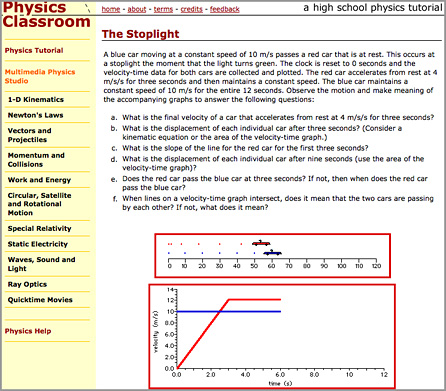Tom Henderson has been teaching high school physics since 1989. ComPADRE, NSDL’s Physics and Astronomy Pathway hosts a popular online physics tutorial that Tom Henderson developed to help high school students at Glenbrook South High School in Glenview, Illinois on the Physics Classroom web site. Physics Classroom resources contain a tutorial with built-in self-assessment tools for checking comprehension, animations and QuickTime media that demonstrate physics in action, and relevant question-and-answer pages. Henderson’s hands-on, basic skill approach seems to be catching on. NSDL webmetrics reports that the Physics Classroom site received more than 600,000 page views during the first week of April.
“A blue car moving at a constant speed of 10 m/s passes a red car that is at rest.” Investigate this animated problem at the Physics Classroom: http://www.physicsclassroom.com/mmedia/kinema/stl.cfm
Teaching physics comes with a built-in set of challenges. In this 1996 article the issues behind helping students through basic physics comprehension as a building block to fascination with, and further study of the precise nature of the physical world is discussed.
“The dominant public perception of physics is that it is tedious, abstract, and fundamentally irrelevant; the challenge in an introductory course is to convince the audience that physics is rewarding, fun, useful, and most of all a worthwhile endeavor.” (Freedman, R., Challenges in Teaching and Learning Introductory Physics)
Most of us think we know how our world works in relation to our daily lives, like, for example,when we stop at a traffic light. Taking a fresh look at the Physics Classroom web site (http://www.physicsclassroom.com/) may provide a few surprises and insights for students of all ages.



Teaching science or math must stress the basic principles. E.g., since it takes forever to reach a black hole, we must not discuss the interior, as this is logically impossible. In general, we must understand how students think and build from there. See “Teaching and Helping Students Think and Do Better” on amazon.